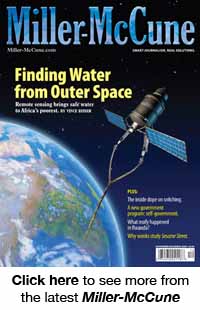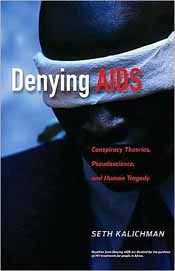On the first page of the preface to his book, Denying AIDS: Conspiracy Theories, Pseudoscience, and Human Tragedy, Seth Kalichman describes his initial encounter with an academic colleague who had written a Web-published screed against the “AIDS myth.” “I mean I was really angry,” he writes, with a sense of frustrated dismay that permeates the book. The dismay is understandable; Denying AIDS is not merely a history of the movement skeptical to widely accepted mainstream science about the disease, but also a detailed account of the author’s personal journey, via lecture halls and message boards, into this world.
The cadre of skeptics on the outer fringes of academia, activism and journalism — who essentially doubt the causal relationship between HIV and AIDS, and oppose the drugs used to treat it — form such a small, but historically crucial, part of the tragic tale of the disease, it’s inevitable that someone who has personally engaged with the movement would have to tell the story. At times the caustic tone of Denying AIDS, understandable as it may be, obscures the cold, hard facts of the book’s arguments. But there’s no doubt that the supposed debate, still thriving on corners of the Internet and well-chronicled in this book, has had sad and serious consequences and holds fascinating implications for other so-called scientific debates, including those surrounding climate change.

Kalichman has a long and lauded history of AIDS prevention work as a widely published author, professor of social psychology at the University of Connecticut and the editor-in-chief of the journal AIDS and Behavior. He is also the director of the Southeast HIV/AIDS Research & Education Project in Atlanta and Cape Town, South Africa, which affords him an up-close view of the impacts of state-sanctioned AIDS skepticism. As Kalichman persuasively makes the case, “Denialism has plagued South Africa nearly as badly as the disease itself.” The country’s second elected president, Thabo Mbeki, rejects the conventional thinking toward the disease and especially the drugs to treat it. Kalichman points to one biography that states, “Mbeki believes that South Africans who espouse the orthodox view that HIV causes AIDS, including Nelson Mandela, the labor unions, as well as AIDS scientists, are financially beholden to drug companies.” Today, Kalichman notes, an estimated 800 people die of AIDS each day in South Africa, while another 1,000 contract HIV.

But it is the history of AIDS in the United States that composes much of the story of the “denialism” movement. This terminology is of course incredibly loaded, as Kalichman admits: Holocaust denialism is an explosive and emotional idea, and 9/11 denialism is associated with a fringe Internet movement of extreme political views. “Still,” Kalichman writes, “I defend my use of the term because I believe it best describes the rejection of objective reality to sustain a flawed, hurtful, and ultimately dangerous belief system.”
In the context of AIDS, Kalichman also applies the term to several academics — although nearly all who write about the topic do not do so in peer-reviewed journals. Henry Bauer, for instance, is professor emeritus of chemistry and science studies and dean emeritus of arts and sciences at the well-regarded Virginia Polytechnic Institute and State University, and he claims his research shows that HIV doesn’t cause AIDS. (He is also, as it happens, a leading authority on the Loch Ness Monster.) Peter Duesberg, who has been on the faculty of the University of California, Berkeley since 1964 and is a full professor of molecular and cell biology, also falls into the “denialist” category. A pioneer in research investigating the genetic bases of cancer, Duesberg was elected to the National Academy of Sciences in 1986.
Around that time, however, Duesberg also made a radical shift in his thinking on the causes of cancer and the role retroviruses play, rejecting much of his previous work and eventually losing his National Institutes of Health funding. Because the retrovirus HIV had been identified as leading to AIDS, Duesberg extended his thinking. Did HIV target and destroy T-cells, according to the emerging and widely accepted view, or was the retrovirus merely a harmless molecular tagalong? As Kalichman writes: “The questions he raised about whether retroviruses can cause AIDS were crystallized as definitive statements in subsequent articles in prestigious scientific journals, defining Duesberg as the most visible dissident AIDS scientist in the world, despite his never actually having done any work on HIV or AIDS.”
Duesberg’s highly alternative point of view gradually gave credence to fringe activist groups like the defunct ACTUP San Francisco, which loudly proclaimed the disease to be a “product of government conspiracy against the gay community,” and just as loudly advocated against the use of retroviral and other HIV-suppressing drugs. And because the tragic story of AIDS has also been shadowed by homophobia, racism and social mores about promiscuous sex, several religious and conservative political leaders throughout the early and mid-1980s adopted skeptical stances against the emerging science that explained the disease. The Reagan administration also infamously bungled the early response to the epidemic. The 1984 press conference (which Kalichman sarcastically labels The Press Conference whenever he refers to it, in an example of his approach) to announce the discovery of the virus that causes AIDS occurred before any scientific journals had published the research, providing skeptics with ammunition to this day, while the administration vowed, without any real basis, to find a vaccine within two years.

Given the attention the disease has received since, it must be curious for some to learn that seemingly intelligent people still question the connections between HIV and AIDS. After all, the fundamental scientific consensus, based on thousands of clinical and laboratory studies since the early 1980s, is that HIV causes AIDS, and as Kalichman points out, “over 130,000 research articles accessed from the National Library of Medicine describe the HIV process.” And when pseudoscience about AIDS seeps into the mainstream media — as was the case in 2006, when a Harper’s magazine article based largely on Duesberg’s research contained at least 50 errors about HIV, according to Kalichman and fellow scientists who wrote in to complain — peer-reviewed academics have every right to be frustrated. “In their minds,” he fumes, “the propagation of the HIV = AIDS myth is the product of a government conspiracy in cahoots with a multibillion-dollar pharmaceutical scam.”
Indeed, Kalichman is at his best when identifying the loose strands that come together to form the various conspiracy theories surrounding AIDS, many of which also apply to other pseudoscience movements. Factors both social and technological contribute: Take a dash of Internet untruths, mix in some irrational fears about Big Pharma or the government, and top it off with growing complacency from educators and public health officials. “Denialism is at least partly an outgrowth of a more general anti-science and anti-medicine movement,” he writes. “Every time there is a recall of approved medications, as happens all too often, public trust is eroded. Campaigns against teaching evolution in favor of creationism, now referred to as Intelligent Design, remain as commonplace today as ever. Conservative political groups have called the peer-review process into question, further heightening suspicions toward science and medicine.”
Refreshingly, Kalichman also takes his colleagues to task for failing to communicate effectively with the public and making too many unfulfilled promises, pointing out that AIDS pseudoscientists, just as in the case of climate change, “have seized on failed scientific predictions in making their point that science is a fraud.”
It’s interesting that Denying AIDS pointedly contains several photographs of the author posing with those on the other side of the debate, including Duesberg, to emphasize the degree to which Kalichman has gone to understand their viewpoint. But it’s also clear, from even a casual perusal of the “blah blah blogs,” as Kalichman happens to call them, that the small, fractious community of AIDS skeptics sees him squarely as the enemy and views his attacks as decidedly personal. If he hasn’t changed any minds, at least Kalichman has provided a thorough chronicle of a fascinating chapter in a long, sad story of a terrible disease. In doing so, he notes, “I have also tried to avoid ad hominem attacks by focusing more on what the denialists are saying than who they are.” And then he adds: “But that was too difficult.”
Sign up for our free e-newsletter.
Are you on Facebook? Become our fan.
Follow us on Twitter.


